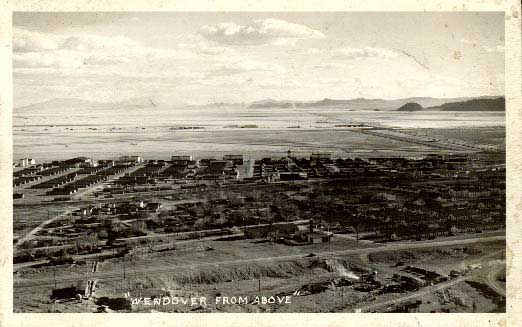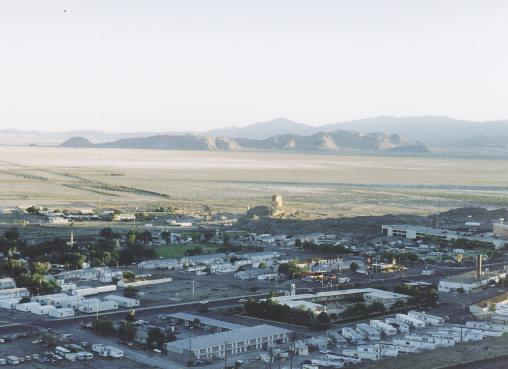
Wendover Air Force Base, 1939-40
Wendover Field was conceived during the late 1930s, and congress appropriated funds in 1940 for the acquisition of land for bombing and gunnery ranges. Wendover was selected because the Great Salt Lake desert with its shimmering salt flats and other vast uninhabited terrain.
The Army Air Corps received 1,822,200 acres and Wendover was established as a sub-post of Fort Douglas on 12 August 1941, when a bombing and gunnery range detachment arrived. Construction began in November 1940 and was completed in 1943; it included a pipeline to a spring at Pilot's Peak, thus ending a water shortage. Wendover Army Air Base was activated on 28 March 1942 as a B-17 and B-24 heavy bombardment training base.
Few buildings were completed and training facilities were scarce when the 306th Bombardment Group arrived on 6 April 1942. A city of salt and other targets were built on the Bonneville Salt Flats by the range detachment. They also installed an electrical system for night illumination and built a machine gun range north of town.
Wendover began training two groups at a time in November 1942, and during 1943 and 1944 fourteen groups completed the course. Training included exercises in high-altitude formation flying, long-range navigation, target identification, and simulated combat missions.
Bombardment training ended in April 1944 when a P-47 fighter aircraft pilot training began and 60 trainees arrived from Louisiana. The program ended in September after three groups, 180 men, had entered training.
In 1942 President Franklin D. Roosevelt established the "Manhattan Engineer District" for the purpose of developing an atomic bomb. By 1944 development of the bomb was under way and the B-29 bomber was selected to deliver the weapon. General Henry "Hap" Arnold, Commander Army Air Forces, named Colonel Paul W. Tibbets, Jr. to head the select team. Only Tibbets knew the mission of the 509th Composite Group, and he chose Wendover Field, Utah, for training because of its isolation and the need for security.
The 393rd Bombardment Squadron (B-29) moved to Wendover in September and the 509th Composite Group was activated in December with a strength of l,767 officers and men, including the First Technical Detachment, a team of civilian and military scientists.
A special ordinance Test Unit assembled inert bombs or "shapes" which were dropped by B-29s to furnish information on ballistics, electrical fusing and detonators, release mechanisms, and flying characteristics of the aircraft. Pits were constructed with hydraulic lifts to hoist the huge bombs into the bomb bay and between October 194 and August 1945, 155 test units were dropped. "Fat Man" tests were performed at Salton Sea Naval Air Station Range, California, and the "Little Boy" was tested on Wendover Range. A high explosive (HE) filled "Fat Man" was tested at Wendover on 4 August 1945 completing the tests.
In January 1945 the 393 left for Cuba, where they flew simulated combat, high altitude, overwater radar bombing and navigation missions. They returned to Wendover and in May received new B-29s which featured lighter engines with fuel injection, reversible electric propellers, pneumatic bomb doors, and a modified tunnel to hold the atomic weapon.
The 509th departed for Tinian, Marianna Islands, in late spring and began flying combat missions, normally one aircraft dropping a "pumpkin" filled with high explosives, but on 20 July an eleven aircraft mission was flown over Japan, each aircraft dropping one bomb.
A successful test of the "Fat Man," called "Trinity Test," took place on 16 July at Alamogordo Army Air Field, New Mexico. President Harry S. Truman warned the Japanese that a bomb of extraordinary power would be used, but the warning was ignored. Colonel Tibbets took off in the "Enola Gay" at 0245 on the morning of 6 August 1945, and Little Boy was dropped at 0915. Colonel Tibbetts immediately executed a diving 155 degree turn to avoid blast and at 0916 the bomb exploded over Hiroshima, Japan. Three days later the "Fat Man" was dropped on Nagasaki. The two bombs killed and injured thousands of people. Japan surrendered on 14 August 1945.
Wendover Army Air Base was transferred to the Ogden Air Technical Service Command (Ogden Air Logistics Center) on 31 December 1945. A detachment of the Special Weapons Branch, Wright Field, Ohio, had arrived at Wendover in October 1944 with the mission of evaluating captured and experimental rocket systems. The missiles were of three types: the first included power-driven bombs such as the German V-1 "buzz bomb;" the second were glide bombs equipped with wings and gyro-stabilizers, which could be controlled by radio or other means. The third consisted of conventional bombs which could be controlled by the launching aircraft. Numerous tests were conducted, including the JB-2, a copy of the German V-1.
Wendover was transferred to the Strategic Air Command (SAC) in March 1947 and used by bombardment groups deploying on maneuvers. A typical exercise consisted of thirty planes departing Wendover on a mission of ten hours and returning to Wendover, where they dropped their bombs.
Wendover Air Force Base, renamed in 1947, was inactivated on 1 October 1949 and transferred to the Ogden Air Material Area in 1950. The range continued to be utilized for bombing and gunnery practice. Tactical Air Command (TAC) reactivated the base in 1954 and tactical units deployed there for exercises. TAC utilized the base for the next four years and spent several million dollars renovating facilities. Wendover was transferred to Ogden in 1958 and renamed Wendover Air Force Auxiliary Field (AAF). The range was renamed Hill Air Force Range in 1960 and the base was again inactivated in January 1969.
In 1955 the Air Force assigned its airmunition functions to Hill AFB, Utah, and construction of an airmunitions and missile test facility (Oasis) was completed in 1964. The mission of the facility was to provide isolated areas for testing airmunitions including missiles, the Minuteman ICBM, "smart bombs," shelf tests of stored munitions, and hazardous material storage. The 2721st Munitions and Maintenance Test Squadron was activated at Hill AFB in 1989 to support storage and testing of airmunitions, including ICBMs, and missile dissection and analysis. Its newest mission is the destruction of nuclear missiles.
An air-to-ground scorable gunnery range was constructed in 1973 and an Air Combat Maneuvering Instrumentation (ACMI) System was installed in 1985. It is an instrumentation tracking system for training aircrews in simulated weapons engagements by fighter-bombers and is in continuous use.
Wendover AAF was declared surplus in 1976 and on 16 June, most of the field, including the water system, was turned over to Wendover, Utah, as a municipal airport. Wendover was renamed Decker Field. Beginning in 1980 the 4440th Tactical Fighter Training Group (Red Flag), Nellis AFB, Nevada, used the field for exercises, but they were discontinued after 1986.
Control of the range was assumed by Air Force Systems Command (AFSC) on 1 January 1979. It was renamed the Utah Test and Training Range (UTTR) with management by the 6545th Test Group at Hill AFB. The Group provides management and evaluation of unmanned vehicles, cruise missile recovery and systems, support of manned air vehicles, missile testing and evaluation. Support for the Air Launched Cruise Missile (ALCM) and the Ground Launched Cruise Missile (GLCM) began in May 1980. The cruise missiles became operational in the mid-l980s.
